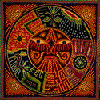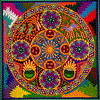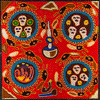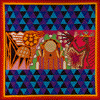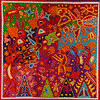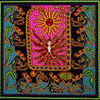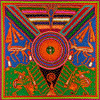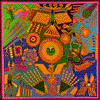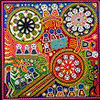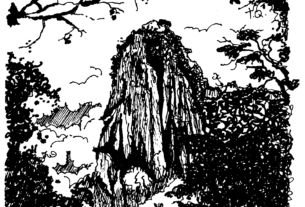Mexican History
The Huichol Indians of Jalisco and Nayarit have accomplished the almost incredible feat of maintaining their independence and most of their traditional values well into the 21st century. Thanks to the rugged terrain of the Sierra Madre mountains the Huichols were able to escape the brunt of the Spanish invasion. They continue to celebrate their independence at the Fiesta of Parikkute during the first 15 days of January, when a change of local governors and civil authorities takes place.
The Huichol never formally acknowledged defeat at the hands of the Spaniards and subsequently have managed to retain much of their language, religion, and culture. While their long-anticipated demise as a separate indigenous people has not yet arrived, new warning signs continue to appear on the horizon and the Huichol continue to be under siege by both secular and religious authorities.
Founded in 1995, the Joshua Project is an organization based in Colorado Springs, USA.. It is a highly organized world-wide evangelical mission dedicated to supporting Christian missions around the world. The emphasis is on the countries, languages, and ethic backgrounds of “unreached peoples” who have not yet been exposed to Evangelical Christianity. The title “Joshua Project” apparently refers to that Joshua who fought the Battle of Jericho until “the walls came tumbling down.” Presumably, in like manner the supposed walls of pagan ignorance and superstition will come tumbling down in the face of the Gospel message. The Joshua Project has its sights set firmly on the Huichol, in particular their religion.
The organizational database on the Huichol provides detailed information on population, religious affiliations, languages, and a profile of the people comprising a series of questions, such as “What are their beliefs?… What are their needs? etc.”. This is followed by a very brief description of their “animistic” religion, with emphasis on the “needs” of the Huichol: “The Huichol are an oppressed people desperately in need of a Saviour. They are entrenched in their worship of spirits and gods, and are fiercely independent, traits which could limit their openness to the Gospel.”
According to the Joshua Project website the Huichol “…held out against Spanish colonialism until the 1720’s.” Actually the Huichol never officially surrendered to the Spaniards, but simply moved farther back into the remote sierras, where most remain to this day. Other somewhat misleading statements include: “Today the Huichols are no longer as isolated and are beginning to become part of the Mexican society and economy.” True, they are under increasing pressure but their isolation and strong cultural traditions continue to protect them to a large extent. Regarding Huichol religion, the website reports that most Huichols are animists who believe that there are spirits in everything. Through their religion they seek to appease these spirits. The Huichol marakame (priest-healer) shaman mediates between gods and humans. A shaman is in direct contact with the gods and through them receives guidance. While the website description is more or less correct, it is nonetheless greatly over-simplified.
One section entitled “Prayer Points” contains, among other petitions, prayers for the missionaries, Huichol believers, and the establishment of churches among the Huichol. One prayer goes thus: “Ask God to raise up prayer teams who will begin breaking up the soil through worship and intercession.” From the missionary point of view “breaking up the soil” undoubtedly means preparing the ground for the complete conversion of the Huichols. Unfortunately, the history of white (European) contact with native peoples shows that the indigenous way of life is indeed broken up by missionary activity, if not completely destroyed, often leaving poverty, dissolution, and hopelessness in its wake. I myself witnessed the devastating effect the U.S military exercise Operation Sweet Briar had on the Indians of Whitehorse, Yukon, in the 1950’s. The soldiers were certainly not missionaries but they contributed to the disruption of Indian society already begun by well-meaning but over-zealous missionaries.
The dry statistics reflect the cold analytical attitude of the Joshua Project towards the Huichol religion, as follows: the Major Religion component comprises Christianity (15.00%), of which 10.50% is evangelical, Ethnic Religions (80.00%), and Non-Religious individuals (5.00%); the Christian segments are Protestant (40.0%) and Roman Catholic (60.0%). It is difficult to see how this evangelical group managed to obtain such precise information on Huichol religion when the Huichols are scattered in small pueblos throughout the sierras as well as in the main Huichol centres of Coyultita, San Andres Cohamiata, and San Sebastian-Santa Catarina. However, this is the basis of their operation.
The Joshua Project subsumes Huichol religion under “Ethnic Religions,” an extremely vague term which hardly begins to describe the complex and highly organized Huichol religion. Like the ancient Aztecs, whom the Huichols claim as their spiritual ancestors, the Huichol yearly Calendar of Fiestas features regular monthly religious celebrations and ritual obligations. To this day Huichols continue to make offerings to the sacred waters, such as Lake Chapala.
In general the Huichol pantheon is divided into two main categories: the deities of the Dry Season and the Deities of the Rainy Season. Two major deities are Tatewarí (Grandfather Fire) and Nakawé (Our Grandmother/Grandfather – Mesoamerican deities were multi-faceted). The former was an ancient Mesoamerican deity, god of the centre and deity of the dry season, the latter a principal ancient god/goddess, creator and destroyer of all that exists. These and other deities are represented in stone carvings and in yarn paintings.
The Peyote Pilgrimage is one of the most important events in the Huichol religious calendar. Starting in October, groups of Huichols make their way to Real de Catorce to begin the hunt for peyote, a key element in Huichol religion.
The Deer-Maize-Peyote complex, or what I shall refer to here as the Huichol Trinity, is a core belief. However, in discussing the extensive and complex features of Huichol religious beliefs and practices it must be remembered that this is still a living tradition. Therefore, academic researchers, popular writers, and casual observers alike record variations in the form in which it is practised by different groups. However, the main line of worship remains the same, although minor variations in interpretation may exist. Of course if the traditional symbols, ceremonies, beliefs and practices change too drastically either from decay and neglect within the society or from outward pressure the traditional religion ceases to exist.
In the Deer-Maize-Peyote complex deer deities are naturally numerous and important. The chief deer, Tamatz Kayamauri (Our Elder Brother Deer Tail), has two deer brothers, who sit on either side of him. Formerly the deer was hunted both for food and ceremonial purposes. With the scarcity of deer nowadays, a bull is generally sacrificed instead at the annual Peyote fiesta.
Maize (Indian corn) is not only a major source of food supply for the Huichols but central to the Huichol religion, for it was Watakame, the Sower or Clearer of the Fields, who taught agriculture to the Huichols. Further, the growth of maize was made possible by the deity Palikata, who sprinkled deer blood on the maize, the main staff of life. Maize therefore has a life or essence of its own and as such must be treated with due respect, for it is the source of nourishment and therefore life itself. In Huichol religious thought one’s state of mind can have an effect on events or natural objects, such as the sowing of the crops. Therefore one must not have bad thoughts when clearing the fields for planting or while harvesting the maize.
The hallucinogenic cactus, peyote, is found in certain parts of Mexico. Known to the Huichols as Dios Hikuri (Peyote God), it was first discovered during the wanderings of the Chichimecas (later known as the Aztecs) from Aztlan to the founding of Mexico-Tenochtitlan. Peyote is said to have sustained them in their hardships throughout their long trek. During the peyote pilgrimage a group confessional takes place. Dios Hikuri can read your thoughts. Therefore, if you do not tell the truth the Peyote god will punish you. Ordinary Huichols take peyote for the pleasant visions it gives them. The marakame or shaman, however, uses it to get in touch with the gods.
The Deer-Maize-Peyote complex or Huichol Trinity is conceived of as a unity in which each part depends on the other. This means, for example, that the maize requires deer or bull blood to make it grow but the deer or bull cannot be sacrificed to the sun until after the peyote hunt, and so forth. The Huichol Trinity also represents the life cycle in its historical, cultural, and religious levels. The deer (or bull) and the maize are the mainstays of the integrated mode of life of the Huichols, while Peyote, like the symbolic body and blood of Christ in the Christian sacrament, is the spiritual elixir that binds together the Deer and the Maize into a veritable three-in-one deity.
In Part Two we shall examine the meaning and significance of both the Christian and the Huichol concepts of the Trinity.

